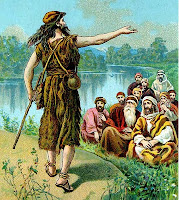I love this little piece of forensic textual criticism. Not sure what weight I'd give it, but it is a little bit of evidence in favour of something or other...
John 3:23 says "Now John also was baptizing at Aenon near Salim, because there was plenty of water, and people were coming and being baptized."
Fine. The only problem with this is that none of the other gospels or any other historical source records a place called Aenon. The place is simply not there. It was claimed to be near Salim/Salem, which is attested elsewhere, but not only is there no mention of Aenon in history, there's no suitable location in geography or archaeology either.
So it appears that John either knew of a place that nobody else knew of, or his source gave him false information. Of course, if the writer of the fourth gospel was fed false information, he can't have been an eyewitness, as some claim, but we came to that conclusion by other means long ago on this blog.
Anyway, assuming that John is working with false information, where did he get this wrong information from? The amazing thing is that textual criticism offers a fairly compelling case for the source.
As you probably know, not all the manuscripts of the new testament documents agree in every detail. Sometimes a 'jot' or 'tittle' is different between two otherwise identical manuscripts, sometimes the odd word has been changed here or there.
One passage in Luke's gospel (3:18) is generally rendered thus: "And with many other words John exhorted the people and proclaimed the good news to them." Its the word 'exhorted' here that is of interest.
In the 'Textus Receptus' (i.e. the generally accepted manuscript of the NT), the Greek word here translated as 'exhorted' is 'parakalon' (sorry for transliterating the Greek into Roman letters, but Greek letters confuse me), but in one variant manuscript (Codex Bezae) the word used is 'parainon', which has basically the same meaning, but is clearly a different word.
D. Paul Glaue ("Der alteste Text der geschichtlichen Bucher des Neuen Testaments," Zeitschrift fur die neutestamentliche Wissenschaft und die Kude der alteren Kirche, Vol 45, 1954, pp. 90-108) pointed out that it looks like the author of John was using an early manuscript of the 'parainon' variant text of Luke as a source and misunderstood the meaning. Remember, he was reading a document which was written all in capital letters, with no spaces between words. So when faced with an unusual letter combination, he wouldn't necessarily know how to break the words apart. Splitting the letters into 'par' (in the vicinity of) and 'ainon' (springs; fountains) gives the text an entirely different meaning, something like: "And [he did] many other things, in the vicinity of Ainon, he [preached] the good news to people." So it looks like John mistook Ainon as a place name, and inferred from it that there was water there, and so it was a good place to do some baptising...
Make of that what you will.
But if it is true, then this is evidence that the author of John copied from the gospel of Luke.
[For more info, read this.]
In the 'Textus Receptus' (i.e. the generally accepted manuscript of the NT), the Greek word here translated as 'exhorted' is 'parakalon' (sorry for transliterating the Greek into Roman letters, but Greek letters confuse me), but in one variant manuscript (Codex Bezae) the word used is 'parainon', which has basically the same meaning, but is clearly a different word.
D. Paul Glaue ("Der alteste Text der geschichtlichen Bucher des Neuen Testaments," Zeitschrift fur die neutestamentliche Wissenschaft und die Kude der alteren Kirche, Vol 45, 1954, pp. 90-108) pointed out that it looks like the author of John was using an early manuscript of the 'parainon' variant text of Luke as a source and misunderstood the meaning. Remember, he was reading a document which was written all in capital letters, with no spaces between words. So when faced with an unusual letter combination, he wouldn't necessarily know how to break the words apart. Splitting the letters into 'par' (in the vicinity of) and 'ainon' (springs; fountains) gives the text an entirely different meaning, something like: "And [he did] many other things, in the vicinity of Ainon, he [preached] the good news to people." So it looks like John mistook Ainon as a place name, and inferred from it that there was water there, and so it was a good place to do some baptising...
Make of that what you will.
But if it is true, then this is evidence that the author of John copied from the gospel of Luke.
[For more info, read this.]

No comments:
Post a Comment